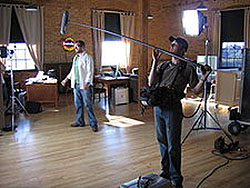
There are times when it’s possible to lose sight of the full scope of your project, which can have unintended consequences.
For instance, when dealing with audio post, you often find that the on-location dialog recordings really stink.
Lets face it, we live in a noisy world, and that noise usually finds its way on to our recordings.
Couple that notion with the bad practice of using inexperienced people in critical sound positions (e.g. boom operator) and poor mic choices (long shotguns in highly reverberant interiors) and it’s no wonder that dialog quality gets compromised.
So, one solution is to re-record the poor dialog lines in post using Automatic Dialog Replacement (ADR).
Despite the name, it’s a fairly simple process. You bring in the talent, playback the bad dialog, and have them parrot the lines while you record their beautiful speech in the confines of a controlled studio environment.
Result: Super clean dialog. Yes!
However, there are some unintended consequences to this approach.
Sure you gain pristine dialog, but it’s often lifeless. I’m not talking about the performances, though that can be avoided too, which we’ll discuss.
The lifelessness to which I’m referring is the room tone of the dialog booth. You see, location dialog recordings pick up the acoustics of a space, the room tone, and all the little noises made by the actors and the environment. ADR has none of this.
To make the ADR work, you have to add back in all kinds of extra sounds. Many of these are delicate and detailed requiring extra effort to bring the reality and ‘life’ back into these ADR lines or the entire scene. Of course, all this time translates into more money spent overall on the project.
Without all these little extra sounds — much of it Foley — the ADR sticks out like … er … ADR! And, often no matter how hard you try to bring your skills to bear, the scene never really works or has the same impact.
Yes, you will have super-clean dialog, but the scene as a whole makes you cringe.
How can it be avoided? Well, I’m glad you asked! Instead of ARD, consider using a technique I like to call BDR (Better Dialogue Replacement).
Using BDR allows you to capture sound on location under more controlled circumstances.
First you the scene is shot for the visual and performance(s). Then the microphone is dipped into the shot, nice and close to the talent, and they perform another take.
Essentially, the ever-essential good picture is shot first, and then you go back and record good sound.
Chances are the actors will still be in the moment and deliver a very similar performance. It might be off sync a bit, but the emotion will be there and you’ll get a better quality ‘wild’ line that you can slip in post as needed.
It’s far, far, far better than ADR, and it allows you to avoid those unintentional consequences which just make you want to cringe.
As always, if you found this please feel free to share them in the comments below.
Jeffrey P. Fisher provides audio, video, music, writing, consulting, training, and media production and post-production services for individuals, corporate, and commercial clients through his own company, Fisher Creative Group. He also writes extensively about music, sound, and video for print and the Web and has authored numerous books and training DVD’s.















